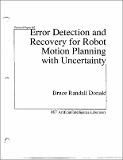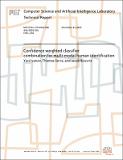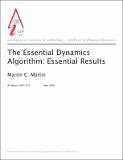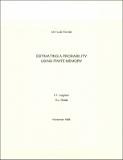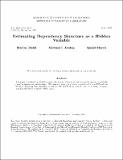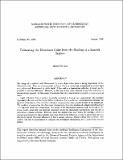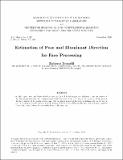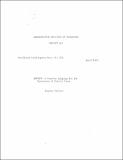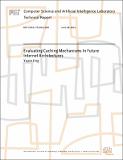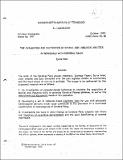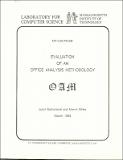Browsing Computer Science and Artificial Intelligence Lab (CSAIL) by Title
Now showing items 1119-1138 of 3804
-
Equivalence Problems in a Model of Computation
(1967-08-01)A central problem in the mathematical teory of computers and computation is to find a suitable framework for expressing the ececution of a computer program by a computer. Within the framework we want to be alble to provide ... -
Error Detection and Recovery for Robot Motion Planning with Uncertainty
(1987-07-01)Robots must plan and execute tasks in the presence of uncertainty. Uncertainty arises from sensing errors, control errors, and uncertainty in the geometry of the environment. The last, which is called model error, has ... -
Error weighted classifier combination for multi-modal human identification
(2005-12-14)In this paper we describe a technique of classifier combination used in a human identification system. The system integrates all available features from multi-modal sources within a Bayesian framework. The framework allows ... -
Essays in Algebraic Simplification
(1972-04)This thesis consists of essays on several aspects of the problem of algebraic simplification by computer. Since simplification is at the core of most algebraic manipulations, efficient and effective simplification procedures ... -
The Essential Dynamics Algorithm: Essential Results
(2003-05-01)This paper presents a novel algorithm for learning in a class of stochastic Markov decision processes (MDPs) with continuous state and action spaces that trades speed for accuracy. A transform of the stochastic MDP ... -
Estimateing a Probability using Finite Memory
(1983-11) -
Estimating Dependency Structure as a Hidden Variable
(1998-09-01)This paper introduces a probability model, the mixture of trees that can account for sparse, dynamically changing dependence relationships. We present a family of efficient algorithms that use EM and the Minimum Spanning ... -
Estimating Dependency Structure as a Hidden Variable
(1997-06-01)This paper introduces a probability model, the mixture of trees that can account for sparse, dynamically changing dependence relationships. We present a family of efficient algorithms that use EMand the Minimum Spanning ... -
Estimating Stereo Disparities
(1967-02-01)An interesting practical and theoretical problem is putting bounds on how much computation one needs to find the stereo-disparity between two narrow-angle stereo scenes. By narrow angle I mean situations wherein the angle ... -
Estimating the Illuminant Color from the Shading of a Smooth Surface
(1988-08-01)\0\05{\0\0\0\0\0\0\0\0 a uniform wall illuminated by a spot light often gives a strong impression of the illuminant color. How can it be possible to know if it is a white wall illuminated by yellow light or a yellow ... -
Estimation of Discontinuous Displacement Vector Fields with the Minimum Description Length Criterion
(1990-10-01)A new noniterative approach to determine displacement vector fields with discontinuities is described. In order to overcome the limitations of current methods, the problem is regarded as a general modelling problem. ... -
Estimation of Inertial Parameters of Rigid Body Links of Manipulators
(1986-02-01)A method of estimating the mass, the location of center of mass, and the moments of inertia of each rigid body link of a robot during general manipulator movement is presented. The algorithm is derived from the ... -
Estimation of Pose and Illuminant Direction for Face Processing
(1994-11-01)In this paper three problems related to the analysis of facial images are addressed: the illuminant direction, the compensation of illumination effects and, finally, the recovery of the pose of the face, restricted to ... -
Etna: a Fault-tolerant Algorithm for Atomic Mutable DHT Data
(2005-06-15)This paper presents Etna, an algorithm for atomic reads and writes of replicated data stored in a distributed hash table. Etna correctly handles dynamically changing sets of replica hosts, and is optimized for reads, writes, ... -
EUTERPE A Computer Language for the Expression of Musical Ideas
(1967-04-01)The electronic medium has vastly increased the amount of material available to the contemporary composer. The various pieces of electronic equipment available today allow one to produce any conceivable sound; yet ... -
EUTERPE-LISP: A LISP System with Music Output
(1967-09-01)EUTERPE (Ai memo no. 129) was designed as a "real-time music program" which would interpret music described as "voice-programs" in DDT. These voice-programs consisted of note words, description of tones to be sounded, and ... -
Evaluating Caching Mechanisms In Future Internet Architectures
(2016-06-28)This thesis seeks to test and evaluate the effects of in-network storage in novel proposed Internet architectures in terms of their performance. In a world where more and more people are mobile and connected to the Internet, ... -
The Evaluation and Cultivation of Spatial and Linguistic Abilities in Individuals with Cerebral Palsy
(1979-10-01)The work of the Cerebral Palsy project (members: Seymour Papert, Sylvia Weir, Jose Valente and Gary Drescher) over the past eighteen months is summarized, and the next phase of activity is outlined. The issues to be ... -
Evaluation of an Office Analysis Methodology
(1983-03)We have developed a model of the office that describes semi-structured office work. This model underlies an office analysis methodology and an office-specification language. An evaluation of the usefulness and practicality ... -
An Evaluation of Concurrent Priority Queue Algorithms
(1991-02)The priority queue is a fundamental data structure that is used in a large variety of parallel algorithms, such as multiprocessor scheduling and parallel best-first search of state-space graphs.


